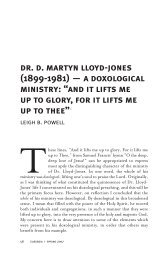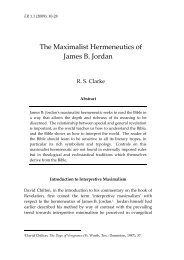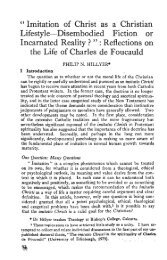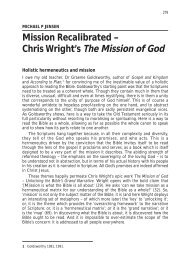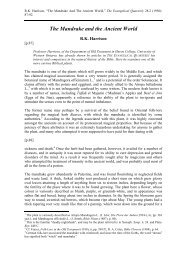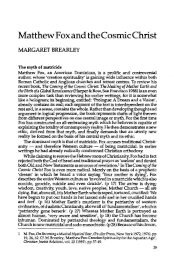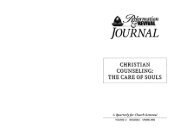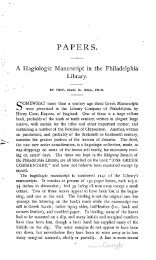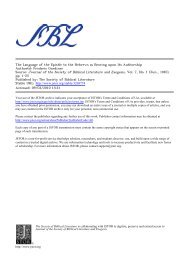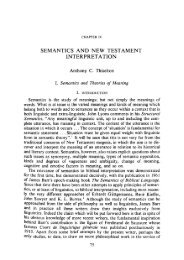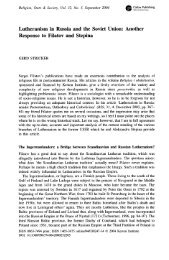Ancient Orient and Old Testament - BiblicalStudies.org.uk
Ancient Orient and Old Testament - BiblicalStudies.org.uk
Ancient Orient and Old Testament - BiblicalStudies.org.uk
Create successful ePaper yourself
Turn your PDF publications into a flip-book with our unique Google optimized e-Paper software.
K.A. Kitchen, <strong>Ancient</strong> <strong>Orient</strong> <strong>and</strong> <strong>Old</strong> <strong>Testament</strong>. London: Inter-Varsity Press, 1966. Hbk. pp.191.<br />
(of the thous<strong>and</strong>s extant) can be fully edited <strong>and</strong> annotated for non-specialists or for members of other<br />
scholarly disciplines. Thus, the Near Eastern material easily accessible to <strong>Old</strong> <strong>Testament</strong> scholarship<br />
is necessarily limited, <strong>and</strong> so between the two fields of study there has long been an inevitable gulf.<br />
Happily, this situation has begun to change somewhat. More <strong>Orient</strong>alists are beginning to contribute<br />
an increasing flow of new data to <strong>Old</strong> <strong>Testament</strong> studies, while <strong>Old</strong> <strong>Testament</strong> scholars are making<br />
more use of this material than ever before. But this flow is still too small, must be much more<br />
increased, <strong>and</strong> must ultimately achieve a far greater impact.<br />
(d) Two Tensions<br />
One more point must now be briefly considered. Through the impact of the <strong>Ancient</strong> <strong>Orient</strong> upon the<br />
<strong>Old</strong> <strong>Testament</strong> <strong>and</strong> upon <strong>Old</strong> <strong>Testament</strong> studies a new tension is being set up while an older one is<br />
being reduced. For the comparative material from the <strong>Ancient</strong> Near East is tending to agree with the<br />
extant structure of <strong>Old</strong> <strong>Testament</strong> documents as actually transmitted to us, rather than with the<br />
reconstructions of nineteenth-century <strong>Old</strong> <strong>Testament</strong> scholarship - or with its twentieth-century<br />
prolongation <strong>and</strong> developments to the present day.<br />
Some examples may illustrate this point. The valid <strong>and</strong> close parallels to the social customs of the<br />
Patriarchs come from documents of the nineteenth to fifteenth centuries BC 21 (agreeing with an<br />
early-second-millennium origin for this material in Genesis), <strong>and</strong> not from Assyro-Babylonian data of<br />
the tenth to sixth centuries BC (possible period of the supposed ‘J’, ‘E’ sources). 22 Likewise for<br />
Genesis 23, the closest parallel comes from the Hittite Laws 23 which passed into oblivion with the fall<br />
of the Hittite Empire about 1200 BC. The covenant-forms which appear in Exodus, Deuteronomy<br />
<strong>and</strong> Joshua follow the model of those current in the thirteenth century BC - the period of Moses <strong>and</strong><br />
Joshua - <strong>and</strong> not those of the first millennium BC. 24<br />
[p.26]<br />
The background to Syro-Palestinian kingship in I Samuel 8 is provided by documents from Alalakh<br />
<strong>and</strong> Ugarit of not later than the thirteenth century BC; 25 this suggests that late in the eleventh century<br />
BC is a late enough date for the content of this passage, <strong>and</strong> would be much more realistic than a date<br />
some centuries later still. Personification of abstracts, like Wisdom in Proverbs 8 <strong>and</strong> g, finds its real<br />
origin not in Greek influences of the fourth century BC but in the wide use of precisely such<br />
personified concepts throughout the <strong>Ancient</strong> Near East in the third <strong>and</strong> second millennia BC, up to<br />
1,500 years before even Solomon was born. 26 Words once thought to be a mark of post-Exilic date<br />
now turn up in Ugaritic texts of the thirteenth century BC, or in even earlier sources. 27<br />
21 See below, pp. 51, 153 f.<br />
22 Compare dates for ‘J’, etc., given by C. R. North in H. H. Rowley (ed.), <strong>Old</strong> <strong>Testament</strong> <strong>and</strong> Modern Study,<br />
1951, p. 81.<br />
23 See below, pp. 51, n. 88; 154 f.<br />
24 See below, pp. 90-102, 128.<br />
25 See below, pp. 158 f.<br />
26 Cf. below, p. 127 <strong>and</strong> note 57.<br />
27 See below, pp. 143-146.




